Sapiens - Guides d'étude, Notes de cours & Résumés
Vous recherchez les meilleurs guides d'étude, notes d'étude et résumés sur Sapiens ? Sur cette page, vous trouverez 693 documents pour vous aider à réviser pour Sapiens.
Page 3 sur 693 résultats
Trier par
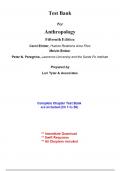
-
Test Bank for Anthropology, 15th Edition by Carol R. Ember, Melvin R. Ember, Peter N. Peregrine
- Examen • 393 pages • 2024
-
- 18,97 €
- + en savoir plus
Complete Test Bank for Anthropology, 15th Edition by Carol R. Ember, Melvin R. Ember, Peter N. Peregrine ; ISBN13: 9780134732879. (Full Chapters included Chapter 1 to 26)....1. What Is Anthropology 2. Research Methods in Anthropology 3. Genetics and Evolution 4. Human Variation and Adaptation 5. Primates: Past and Present 6. The First Hominins 7. The Origins of Culture and the Emergence of Homo 8. The Emergence of Homo sapiens 9. The Upper Paleolithic World 10. Origins of Food Production and Set...
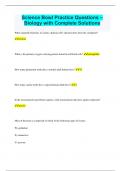
-
Science Bowl Practice Questions – Biology with Complete Solutions
- Examen • 22 pages • 2024
-
Disponible en pack
-
- 9,48 €
- + en savoir plus
Science Bowl Practice Questions – Biology with Complete Solutions What organelle functions to isolate a human cell's chromosomes from the cytoplasm? nucleus What is the primary oxygen-carrying protein found in red blood cells? hemoglobin How many permanent teeth does a normal adult human have? 32 How many canine teeth does a typical human adult have? 4 In the taxonomical name Homo sapiens, what taxonomical rank does sapiens represent? species Most of the heart is composed...
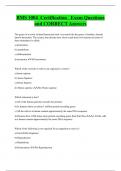
-
BMS 1004 Certification Exam Questions and CORRECT Answers
- Examen • 19 pages • 2024
-
- 9,01 €
- + en savoir plus
The genes of a newly isolated bacterium look very much like the genes of another, already known bacterium. The science that decides how close to put these two bacteria in terms of their relatedness is called: a) proteomics b) metabolism c) differentiation d) taxonomy d) taxonomy Which of the versions to refer to an organism is correct? a) homo sapiens b) /homo Sapiens/ c) Homo Sapiens d) /Homo sapiens/ d) /Homo sapiens/
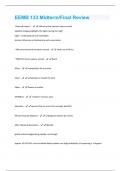
-
EEMB 133 Midterm/Final Review Updated 2024/2025 with complete solutions
- Examen • 44 pages • 2024
-
Disponible en pack
-
- 7,58 €
- + en savoir plus
"Asteroid impact" - Influence that humans have on earth Satellite imaging highlights the lights during the night Light = continuing story of manhattan Human influences on biodiversity and conservation ~2M early hominind ancestors moved - north out of Africa ~70M first Homo sapiens moved - North 50sec - multicellular life to evolve 54sec - vertebrates to invade the land 58sec - flowers to evolve 59.998sec - "modern" humans arise abundant - species that are more than enough; plentifu...
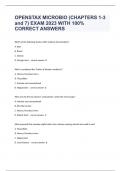
-
OPENSTAX MICROBIO (CHAPTERS 1-3 and 7) EXAM 2023 WITH 100% CORRECT ANSWERS
- Examen • 16 pages • 2023
-
- 15,65 €
- + en savoir plus
Which of the following foods is NOT made by fermentation? A. Beer B. Bread C. Cheese D. Orange Juice - correct answer D Who is considered the "father of Western medicine"? A. Marcus Terentius Varro B. Thucydides C. Antonie van Leeuwenhoek D. Hippocrates - correct answer D Who was the first to observe "animalcules" under the microscope? A. Antonie van Leeuwenhoek B. Ötzi the Iceman C. Marcus Terentius Varro D. Robert Koch - correct answer A Who proposed that swamps...
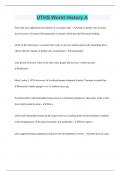
-
UTHS World History A
- Examen • 52 pages • 2024
-
- 11,38 €
- + en savoir plus
UTHS World History A Select the most appropriate description of a nomadic tribe - group of people who traveled from location to location following herds of animals which provided food and clothing which of the following is a scientist that works to uncover artifacts physically unearthing these objects that the remains of people who created them - archaologist what period of history refers to the time when people did not leave written records - prehistory Mary Leakey's 1970s disco...

-
Test Bank for Anthropology, 15th Edition Ember (All Chapters included)
- Examen • 409 pages • 2024
-
- 27,99 €
- + en savoir plus
Complete Test Bank for Anthropology, 15th Edition by Carol R. Ember, Melvin R. Ember, Peter N. Peregrine ; ISBN13: 9780134732879. (Full Chapters included Chapter 1 to 26)....1. What Is Anthropology 2. Research Methods in Anthropology 3. Genetics and Evolution 4. Human Variation and Adaptation 5. Primates: Past and Present 6. The First Hominins 7. The Origins of Culture and the Emergence of Homo 8. The Emergence of Homo sapiens 9. The Upper Paleolithic World 10. Origins of Food Production and Se...
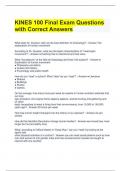
-
KINES 100 Final Exam Questions with Correct Answers
- Examen • 14 pages • 2024
-
Disponible en pack
-
- 11,85 €
- + en savoir plus
KINES 100 Final Exam Questions with Correct Answers What does Dr. Dyreson claim as the best definition of kinesiology? - Answer-The explanation of human movement According to Dr. Dyreson, what are the basic characteristics of "meaningful movement"? - Answer-something that is intentional and has value What "foundations" of the field of kinesiology did Kines 100 explore? - Answer-● Explanation of human movement ● Philosophy and ethics ● Culture and history ● Psychology and...
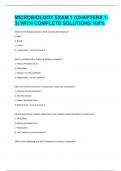
-
MICROBIOLOGY EXAM 1 (CHAPTERS 1-3) WITH COMPLETE SOLUTIONS 100%
- Examen • 18 pages • 2023
-
Disponible en pack
-
- 12,33 €
- + en savoir plus
MICROBIOLOGY EXAM 1 (CHAPTERS 1-3) WITH COMPLETE SOLUTIONS 100% Which of the following foods is NOT made by fermentation? a. beer b. bread c. cheese d. orange juice - correct answer D Who is considered the "father of Western medicine"? a. Marcus Terentius Varro b. Thucydides c. Antonie van Leeuwenhoek d. Hippocrates - correct answer D Who was the first to observe "animalcules" under the microscope? a. Antonie van Leeuwenhoek b. Ötzi the Iceman c. Marcus Terentius Varro ...
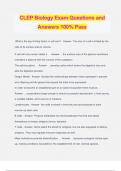
-
CLEP Biology Exam Questions and Answers 100% Pass
- Examen • 18 pages • 2024
-
- 11,85 €
- + en savoir plus
CLEP Biology Exam Questions and Answers 100% Pass What is the key limiting factor on cell size? - Answer- The size of a cell is limited by the ratio of its surface area to volume. A cell will only remain stable if... - Answer- ...the surface area of the plasma membrane maintains a balance with the volume of the cytoplasm. The salivary gland... - Answer- ...secretes saliva which enters the digestive tract and aids the digestive process. Gregor Medel - Answer- Studied the relationships bet...

Ce résumé que vous venez d'acheter a fait très plaisir à quelqu'un. Vous voulez aussi être payé chaque semaine ? Vendez vos documents d'étude sur Stuvia ! Découvrez tout sur gagner de l'argent sur Stuvia


